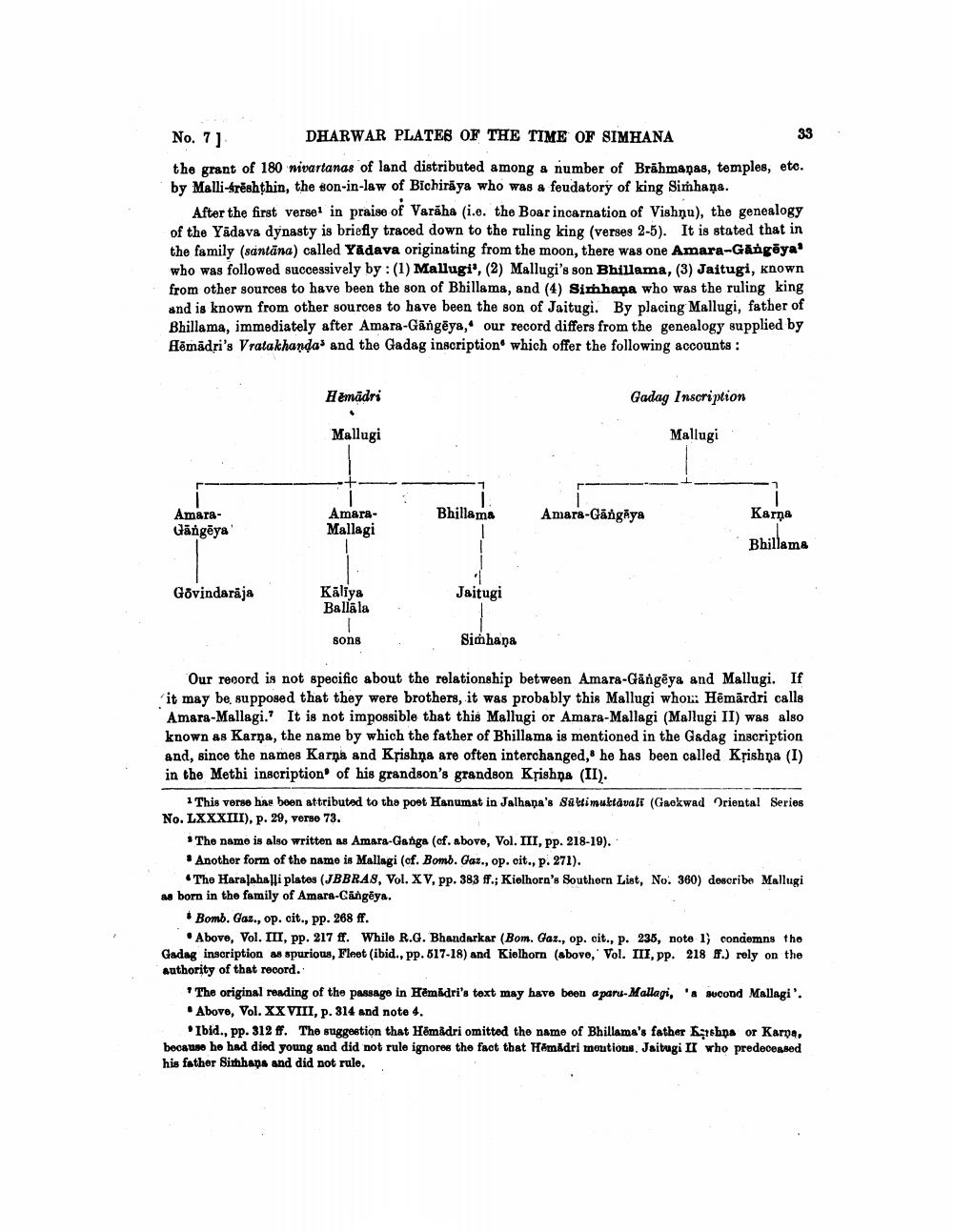________________
No. 71
DHARWAR PLATES OF THE TIME OF SIMHANA
33
the grant of 180 wivartanas of land distributed among a number of Brahmanas, temples, eto. by Malli-Srëshțhin, the son-in-law of Bichirāya who was a feudatory of king Simhaņa.
After the first verse in praise of Varaha (i.e. the Boar incarnation of Vishnu), the genealogy of the Yadava dynasty is briefly traced down to the ruling king (verses 2-5). It is stated that in the family (santāna) called Yadava originating from the moon, there was one Amara-GängĒya' who was followed successively by :(1) Mallugi', (2) Mallugi's son Bhillama, (3) Jaitugi, known from other sources to have been the son of Bhillama, and (4) Simhapa who was the ruling king and is known from other sources to have been the son of Jaitugi. By placing Mallugi, father of Bhillama, immediately after Amara-Gängeya, our record differs from the genealogy supplied by flēmādri's Vratakhandas and the Gadag inscription which offer the following accounts:
Hemādri
Gadag Inscription
Mallugi
Mallugi
Bhillama
Amarađăng@ya'
Karna
AmaraMallagi
Amara-Gāngāya
Bhillame
Govindarāja
Kālīya Ballala
Jaitugi
sons
Simhana
Our record is not specific about the relationship between Amara-Gängęya and Mallugi. If it may be supposed that they were brothers, it was probably this Mallugi whow Hēmārdri calls Amara-Mallagi.' It is not impossible that this Mallugi or Amara-Mallagi (Mallugi II) was also known as Karņa, the name by which the father of Bhillama is mentioned in the Gadag inscription and, since the names Karna and Krishna are often interchanged, he has been called Krishna (I) in the Methi inscription of his grandson's grandson Krishna (II).
1 This verse has been attributed to the poet Hanumat in Jalhana's Saltimuktavali (Gaekwad Oriental Series No. LXXXIII), p. 29, verso 73.
* The name is also written as Amara-Ganga (cf. above, Vol. III, pp. 218-19). • Another form of the name is Mallagi (cf. Bomb. Gaz., op. cit., p. 271).
The Haralahalli plates (JBBRA8, Vol. XV, pp. 383 ff.; Kielhora's Southern List, No. 360) describe Mallugi w born in the family of Amara-Cängěya.
Bomb. Gaz., op. cit., pp. 268 ff.
Above, Vol. III, pp. 217 ff. While R.G. Bhandarkar (Bom. Gaz., op. cit., p. 235, note 1) condemns the Gadag inscription as spurious, Fleet (ibid., pp. 617-18) and Kielhorn (abovo, Vol. III, pp. 218 ff.) rely on the authority of that record.'
* The original reading of the passage in Hēmádri's text may have been aparu- Mallagi, 'a sucond Mallagi'. . Above, Vol. XX VIII, p. 314 and note 4.
Ibid., PP. 312 ff. The suggestion that Hemidri omitted the name of Bhillama's father Cashpa or Karya, because he had died young and did not rule ignore the fact that Hamadri muutious, Jaitugi II who predecessed his father Simhapa and did not rulo.




